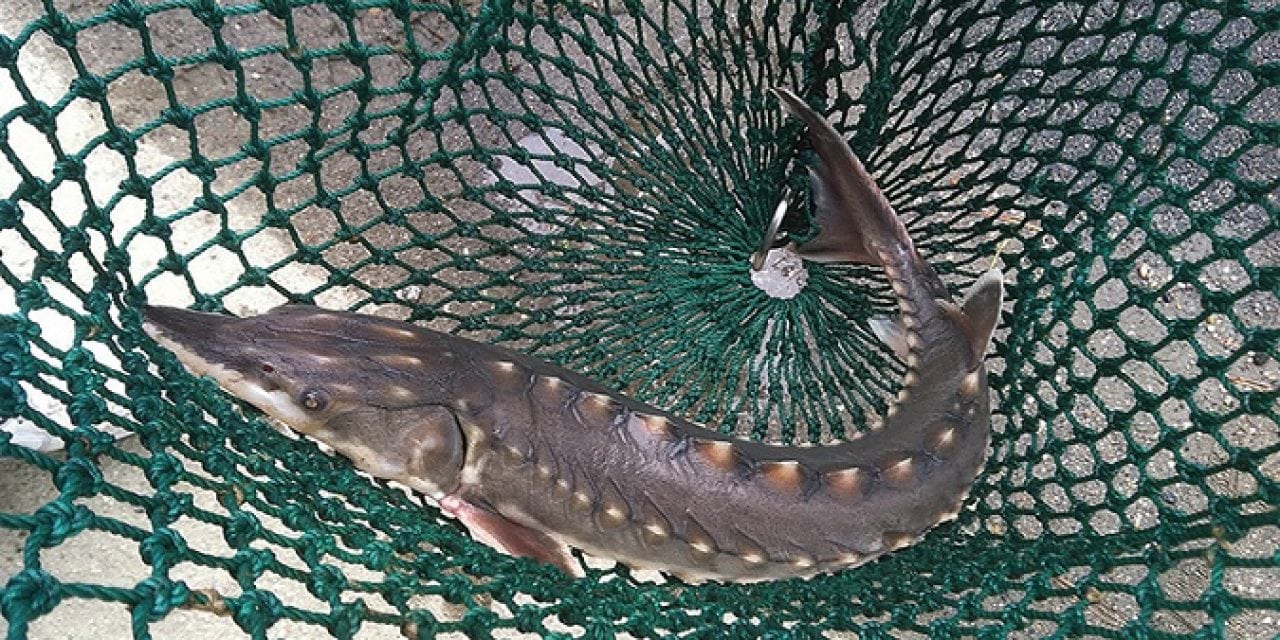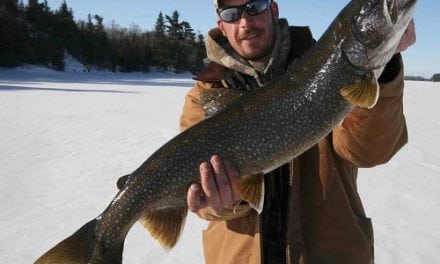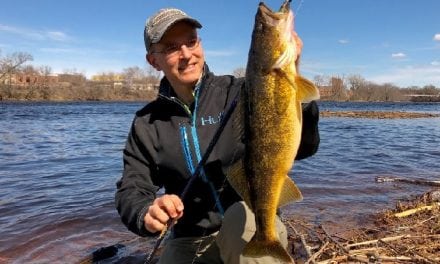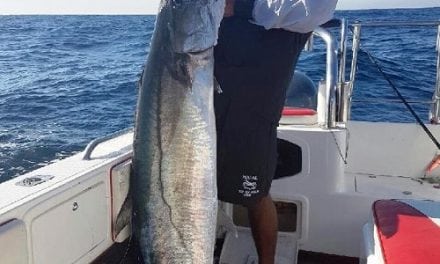In the James River south of Richmond, endangered Atlantic sturgeon have become so common that observant spring and fall boaters are nearly guaranteed to see one breach. It’s hard to miss — a 6– or 7-foot fish exploding out of the water, as if shot from a cannon, wiggling for a split second in midair, then belly-flopping back into the river with a theatrical splash.
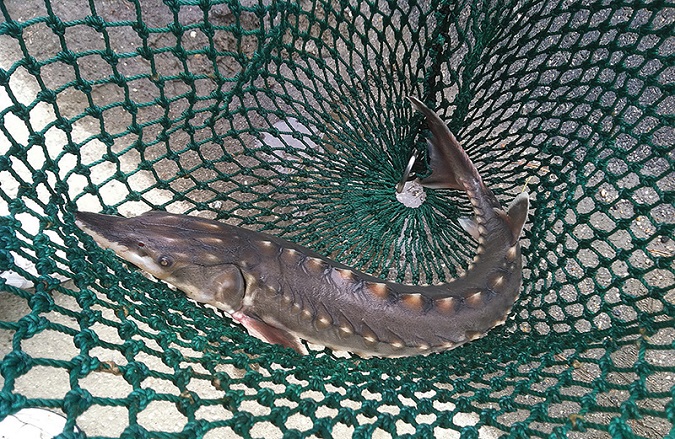
Long-lived and enormous — in its 60-year lifespan it can grow to 14 feet and weigh as much as 800 pounds — the Atlantic sturgeon was harvested to the brink of extinction in the late 1800s. But after a century of marginal existence, this prehistoric-looking fish, with its flat snout and rows of bony plates covering its back, is staging a steady but still fragile comeback in the Chesapeake Bay.
The sturgeon’s increased presence could complicate matters for industrial facilities that draw water from that same stretch of river. In one case, it already has.
After finding two dead sturgeon larvae and one adult in its water intake system in the fall of 2015, Dominion Virginia Power’s Chesterfield Power Station began seeking an “incidental take” permit from the National Marine Fisheries Service, which would allow the company to continue operating despite a potential impact to the endangered fish. In its application for the permit, Dominion estimated that up to 846 sturgeon larvae and maybe two adult fish per year could be trapped or killed in the intakes over the next decade.
The fisheries service, part of the National Oceanic and Atmospheric Administration, will determine in the coming months whether to grant Dominion’s Chesterfield plant a federal permit under an Endangered Species Act provision that allows private entities to “take” a given number of an endangered or threatened species in the process of conducting otherwise lawful operations.
The sturgeon was added to the federal endangered species list in 2012. And this August, NOAA designated several areas in the Bay as critical habitat for the species, including the James River from above Richmond all the way to the Chesapeake. The designation does not impose any new restrictions on fishing, but it requires federal agencies to give additional scrutiny to the habitat impacts of government projects or permit requests.
Dozens of people who commented on the company’s permit application voiced concern that Dominion underestimates the plant’s impact on a species that has only recently begun to recover and that researchers think still struggles to reproduce in the region. In comments submitted to the fisheries service on behalf of the James River Association, the Southern Environmental Law Center urged decision makers to require Dominion to do more to reduce or mitigate the potential impact of the power plant.
“There are a lot of things we don’t know about sturgeon,” said Jamie Brunkow, the Lower James Riverkeeper, during a sturgeon-spotting cruise not far from the Chesterfield facility. “But here we have rare evidence that sturgeon had reproduced not far from this plant,” he added, “and the plant was pulling in those freshly hatched larvae.”
Researchers, Brunkow pointed out, have tagged hundreds of adult sturgeon in the James since 2009, but have found very few larval or juvenile sturgeon.
“We can’t pin all of the sturgeon’s reproductive woes on Chesterfield power station,” he said, “but we do have clear evidence that they are taking sturgeon. So why would we not try to do something about that?”
The Dominion plant in Chesterfield County sits on the banks of a river that used to curve lazily on its way from Richmond to the Bay before engineers carved a straighter channel for navigation.
Through five intakes located deep beneath the river’s surface, the plant draws up to one billion gallons of water per day, predominantly for cooling.
To comply with a 2014 rule issued by the U.S. Environmental Protection Agency, Dominion began to monitor which fish species were being drawn into or trapped against the screen on the Chesterfield water intake that’s intended to keep debris from clogging the pipes.
The plant is one of about a dozen on the Lower James that, depending on how much water they draw from the river, could be required to gather similar information. Under the EPA rule, water intake systems, particularly at older facilities, may have to be modified to prevent or reduce the mortality of aquatic organisms. Initially, though, plant operators are only required to collect and report what’s caught by their intake systems.
Though Dominion is seeking federal approval to take up to 8,500 larval sturgeon and two adults over a 10-year period, Jason Williams, the company’s environmental manager, said he thinks the 2015 intake of sturgeon could have been an isolated event.
“We went through this process, even though the likelihood of encountering additional larvae is very low,” Williams said. Dominion officials say their estimate of 846 larval sturgeon per year is higher than it probably needs to be — and is a number that’s not especially reliable because of the small sample size.
But the law center contends that according to a report it commissioned by a University of Massachusetts Amherst researcher, the water intakes could kill tens of thousands of young sturgeon in the decade covered by the permit. Environmental groups are also concerned that other aspects of the plant’s operations — particularly the discharge of heated water — could hurt sturgeon’s ability to reproduce and thrive in the lower James.
Julie Crocker, endangered fish recovery coordinator for the fisheries service, which will determine whether to grant Dominion the permit, said the law center’s objections are the most substantive of nearly 40 received by the end of the comment period in mid-September.
The agency already suggested shortening the duration of Dominion’s take permit from 20 to 10 years. After factoring in public comments, Crocker said officials could decide to reduce the time period even further, given the nascent stage of sturgeon research. The agency also will determine if the company has proposed sufficient mitigation measures and whether its take estimates appear accurate.
“One of the reasons we believe these permitting steps are beneficial is that, without a requirement to monitor for Atlantic sturgeon, we really don’t know what’s going on and we can’t quantify the threat that facilities like this might be having on the species,” Crocker said.
The incidental take permit that Dominion is pursuing is a rarity so far in the Bay region, although federal agencies often use a similar provision when their projects impact endangered species, Crocker said.
In 1998, a pair of power plants on the Hudson River received a permit to take a few similarly endangered shortnose sturgeon a year, after the fish were found in water intakes there. Regulators agreed that the small number of sturgeon killed by the Hudson River plants would not affect the overall health of the species. The facilities are currently renewing those permits and have taken “very low” numbers of sturgeon in the two decades since, in part because of efforts to reduce the amount of water withdrawn by the plants.
As part of its permit application, Dominion submitted a “habitat conservation plan” that details ways the company would minimize impacts on sturgeon — though literally conserving habitats is not one of them.
Dominion’s application says surveys show there are enough of the rocky reefs in the river on which sturgeon prefer to spawn in this portion of the James, so there’s no “definite, quantifiable benefit” to creating or enhancing such habitat.
The company instead proposes using its take permit to add to the available body of research about sturgeon, providing any samples collected to biologists eager to learn more about the genetic makeup, seasonal presence and spawning habits of the species.
But Dominion is not proposing any changes to its intake system or to the volumes of water drawn from the river at the Chesterfield facility, saying the plant is critical to supplying power for the region. Modifying round-the-clock operations to reduce water withdrawals — and the number of sturgeon impacted — “would be impractical,” the company said. There’s no intake design that’s been proven to prevent sturgeon from being sucked in and trapped, it said.
The Dominion environmental manager also pointed out that, in renewing the plant’s water withdrawal permits, the company will likely be required by the new federal rule to use the best available technology to exclude fish species anyway. Those requirements will depend on the findings of its monitoring process. The options range from installing finer screens to constructing cooling water towers or water recirculation units, which Dominion already uses at some of its newer facilities.
“We anticipate that some of our [power plants] will have some changes as a result of that rule,” Williams said.
But Brunkow, the riverkeeper, thinks the take permit should require Dominion to address more of these issues now — and that the sturgeon’s recovery cannot wait.
“What is the combined effect?” Brunkow questioned. “It’s not just the sturgeon. We know that all kinds of species get [caught] in these systems.”
Dominion has two other power plants downriver, at Surry and Yorktown, which are also in the process of reporting which, if any, fish species are found in their water intake systems. If sturgeon are identified, that could add pressure on the industry to change the way it operates in critical habitats such as the James.
(As originally posted, this story improperly credited the photograph of an Atlantic sturgeon in a net. The Bay Journal regrets the error.)
The post Hurdles For The Endangered Sturgeon of the James River appeared first on ODU Magazine-North America’s #1 Digital Fishing Magazine.

